Understanding Calgary’s Domestic Violence Statistics: Patterns and Predictions
Key Insights
| The Calgary Women’s Shelter states that domestic violence continues to be a major concern in Calgary, with 5,161 crimes reported in 2023. A report by the Government of Canada reveals how abuse takes many forms, with assault cases rising to over 4,000 in 2023. Statistics Canada highlights that there were 139,020 victims of family violence, and 123,319 cases of intimate partner violence in Calgary. The University of Calgary School of Public Policy further shows how domestic violence is widespread in Calgary, with police responding to an average of 12 calls per day. Data from the Calgary Foundation’s Quality of Life Report (2024) illustrates how 59% of Calgarians show concern for issues of domestic violence. |
Calgary Domestic Violence Statistics: Trends and Insights
The Calgary Women’s Shelter states that domestic violence is still a pressing issue in Calgary, with the latest figures showing a rise in reported cases.
In 2023, 5,161 domestic violent crimes were reported by the Calgary Police Services, which is a 9.3% increase from the 4,723 cases in 2022.
Most of these were cases of assault, with 4,072 incidents in 2023 and 3,671 in 2022. This shows an increase of 10.92% in two years.
Meanwhile, sexual offenses amounted to 426 in 2023 and 437 in 2022.
The frequency of calls to the Calgary Police Service for domestic incidents further highlights the gravity of the situation. Police received 23,890 domestic-related calls in 2023 alone, averaging around 1,990 calls per month.
This large number indicates continuous issues with domestic violence throughout the city.
Furthermore, of the 21 homicides reported in 2023, three are believed to be domestic-related. This supports the life-threatening nature of domestic violence cases.
In addition to crime statistics, public opinion indicates strong concern for the problem.
In the Calgary Foundation’s Quality of Life Report (2024), 59% of Calgarians indicated concern regarding domestic violence rates, suggesting increased awareness and a need for better intervention measures.
With the growing number of domestic violence complaints, wider victim assistance programs, enhanced enforcement policies, and wide-ranging prevention programs could aid the city.
| Year | Total Domestic-Related Violent Crimes | Assaults | Sexual Offenses | Homicides | Domestic Calls Received |
| 2022 | 4,723 | 3,671 | 437 | 4 | N/A |
| 2023 | 5,161 (+9.3%) | 4,072 (+10.9%) | 426 (-2.5%) | 3 (-25%) | 23,890 (1,990/month) |
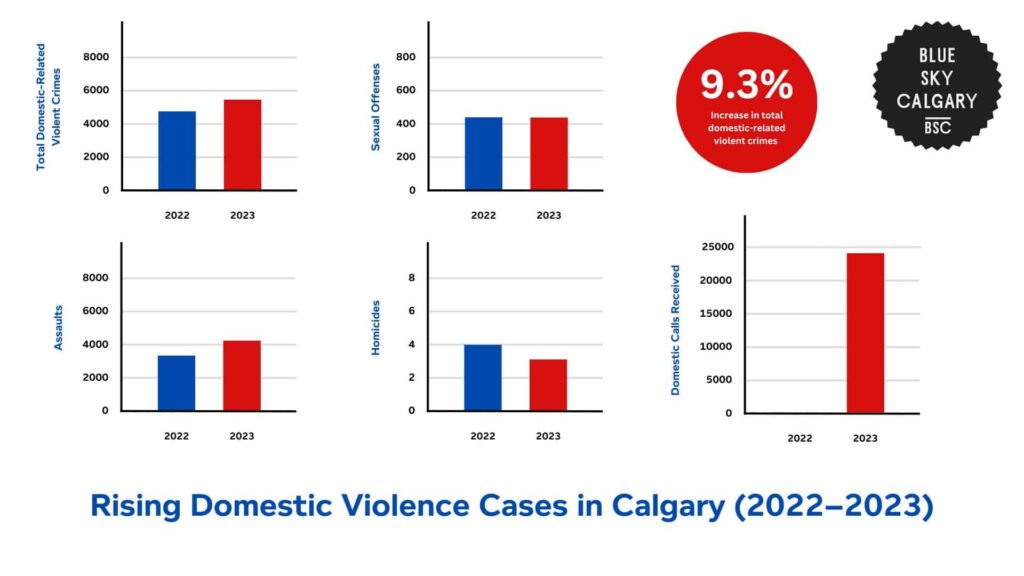
Trends in Domestic Violence Across Canada
Statistics Canada shows that intimate partner violence (IPV) and family violence continue to be key issues in Calgary, with current statistics indicating an increase in police-reported cases in the city.
In Canada, 139,020 people were the victims of family violence, and 123,319 cases of IPV were reported among those aged 12 years and older.
These numbers equate to 350 victims of family violence and 354 victims of IPV for every 100,000 individuals.
Moreover, family violence between 2018 and 2023 rose by 16% in urban cities, while IPV cases rose by 12% between the same years.
Although northern Canada still has the highest rates of family and intimate partner violence, urban cities like Calgary are also showing a constant escalation of cases. This places greater pressure on local law enforcement and support networks.
Though Saskatchewan and Manitoba posted the most elevated provincial rates, Calgary has also witnessed a steady rise in domestic violence incidences, with police attending close to 24,000 domestic-related calls in 2023.
As a metropolitan hub, Calgary is faced with special challenges such as housing instability, economic gaps, and difficulties in reporting cases, which all contribute to the recurrence of IPV and family violence in the city.
Overall, violent crime in urban areas increased by 19%, which represents a wider trend of increasing crime that overlies domestic violence cases.
| Region | Family Violence Rate (per 100,000) | IPV Rate (per 100,000) | Change in Family Violence (2018-2023) | Change in IPV (2018-2023) |
| Northern Canada | 1,062 | 1,073 | 0.22 | 0.21 |
| Rural South | 441 | 393 | 0.2 | 0.17 |
| Urban South | 299 | 299 | 0.16 | 0.12 |
| Saskatchewan | 741 | 710 | N/A | N/A |
| Manitoba | 588 | 628 | N/A | N/A |
| Ontario (lowest rate) | 238 | 269 | N/A | N/A |
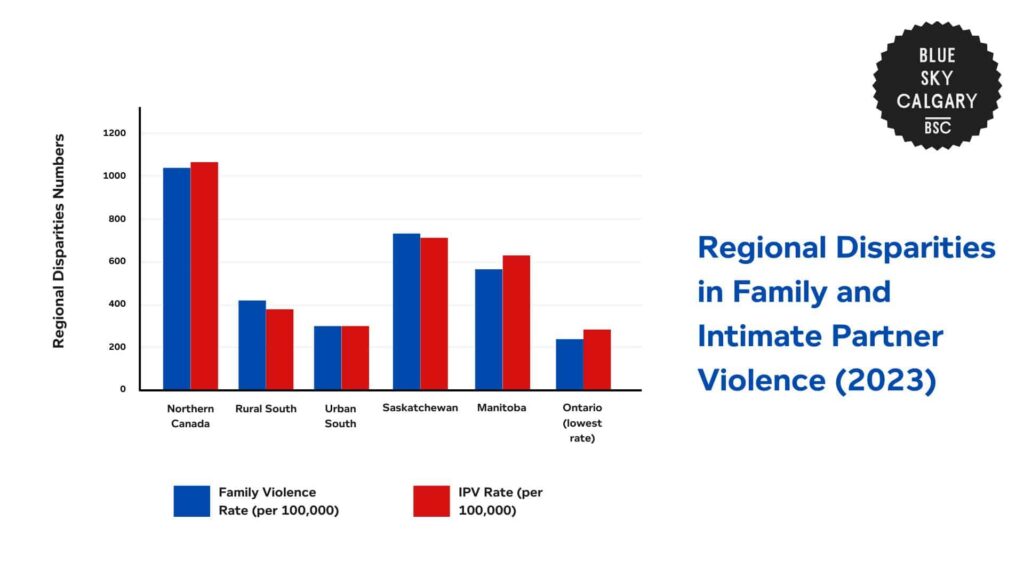
The Trend of Male Perpetrators in Domestic Violence Cases
A recent study from the University of Calgary School of Public Policy highlights that home violence continues to be an important challenge for Calgary.
The Calgary Police cited 4,666 domestic violence instances with laid charges in 2019, along with 13,858 domestic disputes where the police intervention did not warrant criminal charges.
These statistics show that domestic violence cases are common in the city, with a daily average of 12 calls for police action.
Moreover, the research discovered that 88% of Calgary perpetrators of domestic violence were men, which is consistent with wider patterns of gendered violence.
Of a sample of 934 Calgary men charged with domestic violence in 2019, 71% committed the offense against a female intimate partner.
More significantly, 73% of these men had previous police contacts in the past 10 years leading up to their charge, reflecting a pattern of repeat offending or criminal history.
The predominant offenses were common assault (57%) and assault with a weapon (21%), further indicating the severity of violence between intimate partners within the city.
These results suggest that domestic violence in Calgary is not merely a string of isolated occurrences but a habitual pattern among a subgroup of perpetrators.
| Category | Calgary-Specific Findings |
| Total domestic violence cases (charges laid) | 4,666 |
| Domestic conflicts requiring police intervention (no charges) | 13,858 |
| Male offenders | 88% of perpetrators |
| Cases involving female intimate partners | 71% of charged perpetrators |
| Repeat offenders (prior police history) | 73% had prior interactions with law enforcement |
| Common assault charges | 57% of charged perpetrators |
| Assault with a weapon charges | 21% of charged perpetrators |
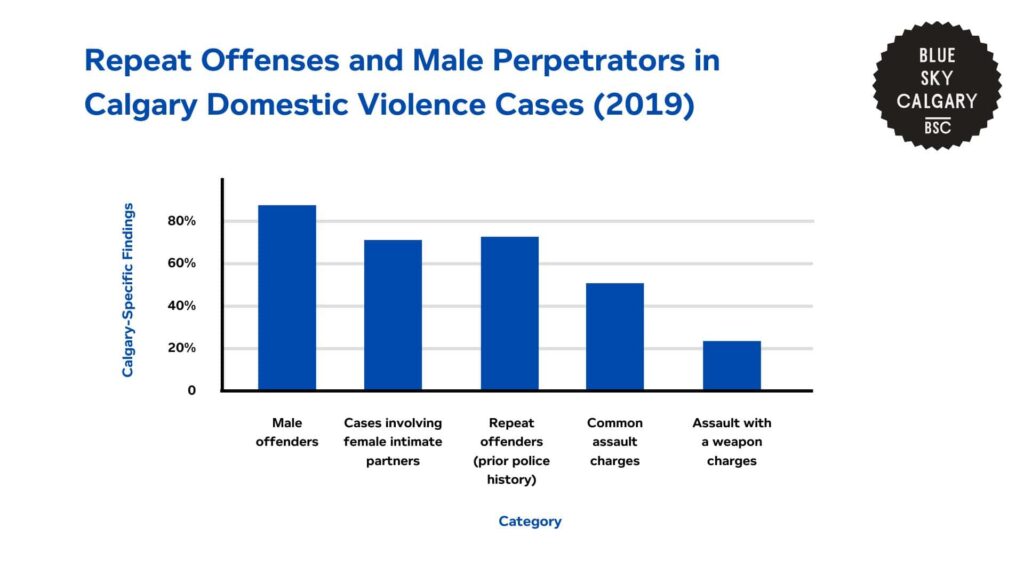
Demographic Breakdown of Domestic Violence Victims
Statistics Canada gives a closer look at which demographic groups are affected the most by family and intimate partner violence.
Family and intimate partner violence continues to affect specific demographic groups in Canada disproportionately.
In 2023, women and girls accounted for 68% of all family violence victims and 78% of IPV victims, making them the most affected population.
The rate of family violence for women and girls stood at 473 victims per 100,000, which was twice as high as that of men and boys (220 per 100,000).
Women were more often victimized by spouses (31%) and other family members (25%), while men were more frequently harmed by other family members (29%) and spouses (21%).
This gap is even wider in IPV cases, where women and girls experienced violence at a rate of 549 per 100,000, which is nearly four times higher than the rate for men and boys at 155 per 100,000.
However, young women remain the most at-risk group for IPV. In 2023, women aged 12 to 24 years experienced IPV at a rate of 752 victims per 100,000, nearly seven times higher than men in the same age group (111 per 100,000).
Despite a larger percentage increase in reported violence among men in recent years, women and girls overwhelmingly remain the primary victims.
Children and youth have also been significantly impacted by family violence. In 2023, there were 26,777 reported victims aged 17 and younger, marking the highest recorded level since 2009.
Girls made up 62% of these victims, with a family violence rate of 439 per 100,000. This is also nearly twice as high as the rate for boys, which is at 259 per 100,000.
Parents were the most common perpetrators, accounting for 60% of cases, followed by siblings (16%) and other family members (24%).
Since 2018, the overall rate of family violence among children and youth has increased by 32%, with a larger rise among girls (+28%) than boys (+24%).
Seniors have also seen a sharp increase in family violence. In 2023, 7,054 seniors aged 65 and older were victims of family violence, with women making up 57% of all cases.
The rate of family violence for seniors reached 94 victims per 100,000, which is also the highest recorded level since 2009.
Family violence among seniors has increased by 42% since 2018, with a larger rise among men (+46%) than women (+39%).
These findings highlight the urgent need for targeted intervention programs to address family and intimate partner violence among women, youth, and seniors.
| Demographic Group | Total Victims | Rate per 100,000 | Primary Perpetrators | ChangeSince 2018 |
| Women & Girls (Family Violence) | N/A | 473 | Parents, Spouses, Other Family | 0.15 |
| Men & Boys (Family Violence) | N/A | 220 | Parents, Siblings, Other Family | 0.19 |
| Women & Girls (IPV) | N/A | 549 | Intimate Partners | 0.12 |
| Men & Boys (IPV) | N/A | 155 | Intimate Partners | 0.2 |
| Children & Youth (0-17) | 26,777 | 362 | Parents (60%), Siblings (16%) | 0.32 |
| Senior Women (65+) | N/A | 99 | Spouse (31%), Other Family (25%) | 0.39 |
| Senior Men (65+) | N/A | 87 | Other Family (29%), Spouse (21%) | 0.46 |
| Women (12-24, IPV) | N/A | 752 | Intimate Partners | -3% |
| Men (12-24, IPV) | N/A | 111 | Intimate Partners | -3% |
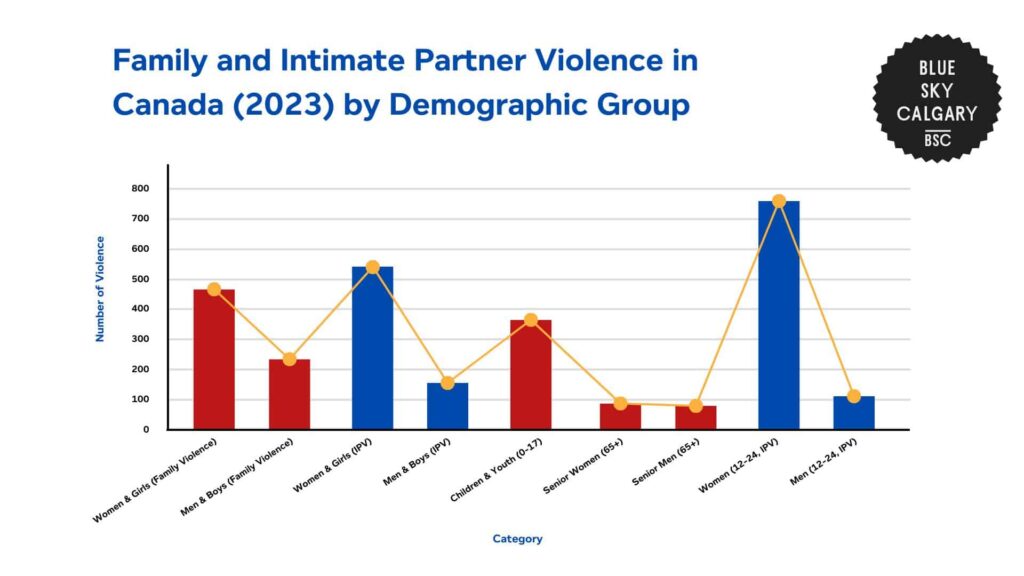
Costs and Consequences of Domestic Violence in Calgary
The Government of Canada reveals how different forms of abuse continue to be serious problems in Calgary, with cases of domestic violence increasing over the past few years.
In Calgary, domestic violence has been steadily rising, with over 4,000 reported cases of assault in 2023. These numbers reflect just a fraction of the actual incidents, as many cases go unreported due to fear, financial dependence, or lack of resources.
The consequences of abuse extend far beyond the immediate act of violence, affecting victims’ ability to work, access stable housing, and rebuild their lives.
Financial Strain and Economic Dependence
Victims of abuse often incur large financial burdens. They face medical expenses for injuries, the cost of therapy for trauma, and legal fees if they pursue protection orders or custody battles.
Moreover, financial abuse further traps victims by limiting their access to money, making it nearly impossible to leave the relationship they are in.
Given Calgary’s rising living expenses, many women escaping abusive relationships struggle to secure housing and employment, leaving them at risk of homelessness or returning to their abuser.
Psychological Trauma and Emotional Damage
The psychological toll on victims is also severe. Emotional abuse, which is often overlooked, can lead to long-term mental health struggles like depression, anxiety, and PTSD.
In 2023 alone, Calgary police responded to 23,890 domestic-related calls, many likely involving cases where victims were manipulated, degraded, and controlled.
Survivors often struggle with trust issues and self-worth, making it harder to form healthy relationships or seek help.
The stigma surrounding abuse, particularly sexual violence, makes reporting even more difficult.
Despite being one of the least reported crimes, 426 domestic-related sexual offenses were documented in Calgary in 2023, yet many more likely remain unreported due to shame and fear of retaliation.
The Cycle of Neglect and Abuse Across Generations
The cost of neglect or failing to intervene, often in cases of child abuse, leaves long-term effects on victims.
Childhood trauma linked to abuse raises the risk of future mental health issues, substance abuse, and even violent behavior later in life.
Without proper intervention, these patterns of abuse continue across generations, creating a cycle that places ongoing strain on social services, healthcare systems, and law enforcement.
| Type of Abuse | Definition | Examples | Impact on Victims |
| Physical Abuse | Use of force to harm or control | Hitting, choking, burning, stabbing | Physical injuries, trauma, fear |
| Sexual Abuse | Non-consensual sexual acts | Forced intercourse, coercion, child exploitation | Psychological trauma, physical harm |
| Emotional Abuse | Verbal and psychological control | Insults, threats, controlling behavior | Low self-esteem, anxiety, depression |
| Financial Abuse | Controlling or exploiting finances | Restricting access to money, coercing financial decisions | Economic dependence, inability to leave abuser |
| Neglect | Failure to provide basic needs | Lack of food, medical care, supervision | Malnutrition, developmental issues, increased vulnerability |
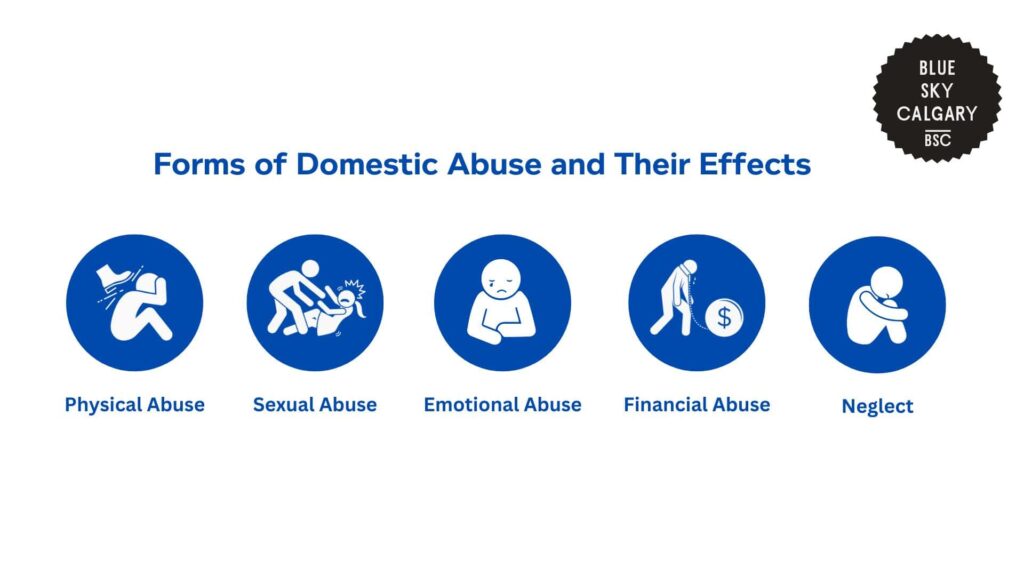
Solutions and Interventions to Domestic Violence in Calgary
The Calgary Women’s Shelter illustrates that the prevention of domestic violence in Calgary needs to be addressed through a coordinated effort involving prevention programs, intervention, and specialized treatment for victims and offenders.
Current statistics show that domestic violence cases in Calgary continue to rise, with police responding to almost 24,000 domestic-related calls in 2023 alone. To curb this growing trend, a holistic approach is necessary.
Early Prevention and Education for Young People
Programs like Safe Dates and The Fourth R have been incorporated into Canadian school curriculums to educate adolescents (ages 13 to 16) on healthy relationships, consent, and conflict resolution.
Since dating violence is often linked to future domestic violence cases, these programs help prevent young people from developing abusive behaviors as adults.
Expanding these initiatives in Calgary schools could help promote healthier relationship patterns and reduce rates of intimate partner violence in the long term.
Challenging Harmful Gender Norms
Another crucial intervention involves programs for men and boys designed to challenge toxic gender norms that contribute to domestic violence.
Programs like Coaching Boys into Men and Mentors in Violence Prevention engage boys in conversations about power, control, and violence against women, encouraging them to be allies in preventing abuse.
For adult men, peer-group interventions, workplace training, and workshops, such as the One Man Can Program, focus on reshaping attitudes toward women and promoting healthier behavior.
Given that most perpetrators of domestic violence in Calgary are male, expanding these programs citywide could significantly reduce future violence by addressing problematic behaviors early.
Supporting Survivors and Breaking Financial Dependence
The availability of accessible victim support programs is also essential in minimizing domestic violence cases in Calgary.
Counseling, support groups, and advocacy programs assist survivors in healing and becoming independent again.
Furthermore, various organizations provide victims with access to mental health services, safety planning, and legal assistance to facilitate them to move to safer places.
Since financial dependence is a major barrier preventing victims from leaving abusive relationships, emergency financial assistance and employment support programs are crucial for survivors seeking long-term stability.
Rehabilitating Offenders
Perpetrator treatment programs also have a crucial role in ending the cycle of domestic violence.
Many rehabilitation programs use psycho-educational models to help abusers recognize and change their perceptions of power, control, and gender roles.
Programs like Responsible Choices for Women and Strength to Change integrate cognitive-behavioral therapy and conflict resolution training to lower repeat offenses.
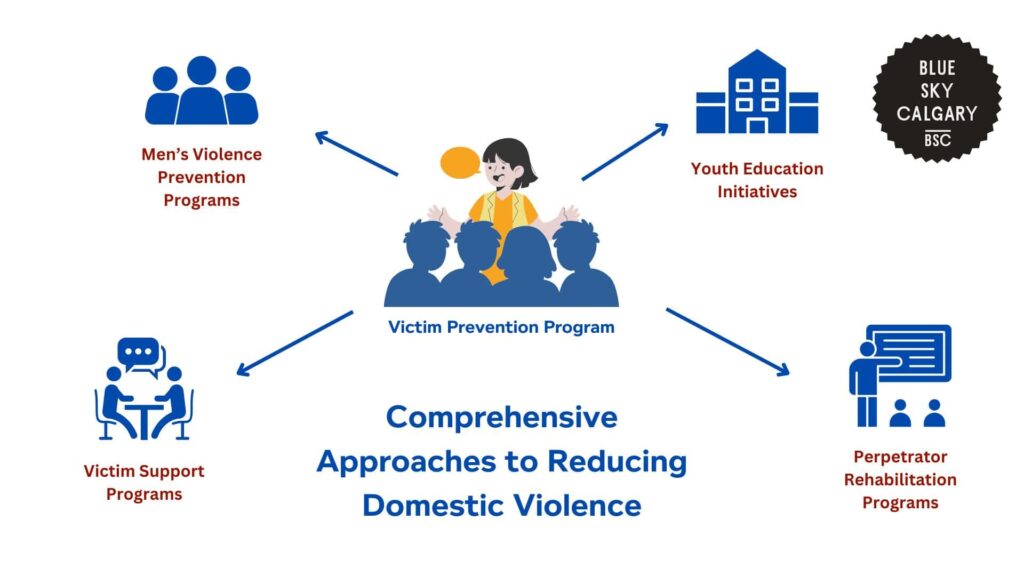
Projections for Domestic Violence Trends in Calgary
Domestic violence in Calgary has been on an upward trend, with reported incidents increasing annually. There were 5,161 cases in 2023, which is a 9% increase from the year before.
If this trend continues, Calgary may have more than 7,000 cases by 2027. Moreover, the volume of calls may reach more than 25,000 per year in the coming years.
Some demographic groups are more likely to suffer from domestic violence. Women and adolescent girls (12–24 years) are still at the highest risk, as they already endure the highest rates of intimate partner violence (IPV).
Aside from demographic threats, economic and social influences will dictate future domestic violence trends. Financial struggle, housing instability, and job loss have fueled increases in domestic violence.
Existing intervention programs, including men’s violence prevention programs, victim support programs, and perpetrator rehabilitation programs, have been promising, but their long-term success is not yet known.
If these initiatives are expanded, the city can experience a reduced rate of growth or even a decrease in domestic violence rates after 2026.
Although forecasts suggest that Calgary’s domestic violence rates will continue to grow, community-based interventions, stronger legal actions, and additional funding for prevention programs show promise in changing these trends.
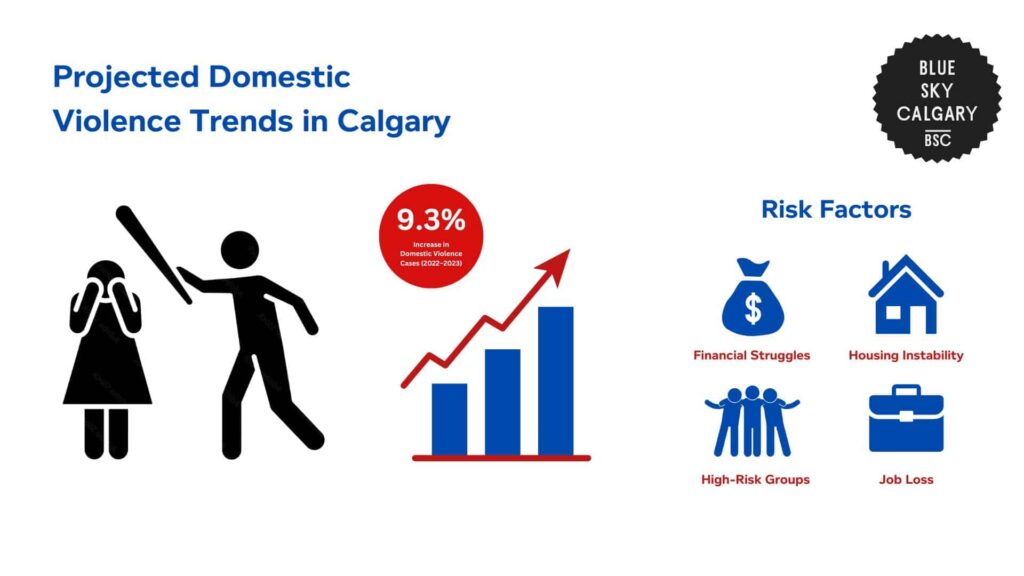
References
- Calgary Women’s Shelter. (n.d.). Statistics and research. Retrieved from https://www.calgarywomensshelter.com/learn/statistics-and-research
- Calgary Foundation. (n.d.). Quality of life report. Retrieved from https://calgaryfoundation.org/about-us/publications/quality-of-life-report/
- Fear Is Not Love. (n.d.). Impact and statistics. Retrieved from https://fearisnotlove.ca/impact-and-statistics/
- Statistics Canada. (2024, October 24). Police-reported family violence and intimate partner violence, 2023. The Daily. Retrieved from https://www150.statcan.gc.ca/n1/daily-quotidien/241024/dq241024b-eng.htm
- Department of Justice Canada. (n.d.). Impact on Canadians. Retrieved from https://www.justice.gc.ca/eng/cj-jp/fv-vf/about-apropos.html#:~:text=Impact%20on%20Canadians
- Calgary Women’s Shelter. (2014, June). Prevention & early intervention: Domestic violence prevention. Retrieved from https://www.calgarywomensshelter.com/images/pdf/Prevention&EarlyIntervention_DV_FCSSJune2014.pdf
- Government of Canada. (n.d.). Safe dates and healthy relationships. Women and Gender Equality Canada. Retrieved from https://www.canada.ca/en/women-gender-equality/campaigns/gender-based-violence-its-not-just/safe-dates-and-healthy-relationships.html#:~:text=A%20%E2%80%9Csafe%20date%E2%80%9D%20is%20a
- Youth Relationships. (n.d.). Youth relationships initiative. Retrieved from https://youthrelationships.org/
- Futures Without Violence. (n.d.). Coaching boys into men. Retrieved from https://www.endvawnow.org/uploads/browser/files/Coaching%20Boys%20into%20Men.pdf
- Education MVP. (n.d.). Education MVP: Resources for youth programs. Retrieved from https://educationmvp.co.uk/
- Sonke Gender Justice. (n.d.). One Man Can campaign. Retrieved from https://www.comminit.com/unicef/content/one-man-can-campaign


